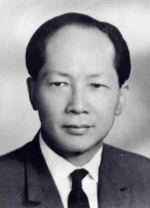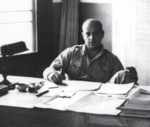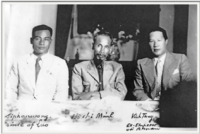Nguyen Ngoc Bich: Difference between revisions
Loc Vu-Quoc (talk | contribs) (→Ho Chi Minh: external links to replace interwiki links for CZ) |
Loc Vu-Quoc (talk | contribs) No edit summary |
||
| Line 212: | Line 212: | ||
{| cellpadding=0 cellspacing=0 | {| cellpadding=0 cellspacing=0 | ||
|- | |- | ||
! width="100%" | | ! width="100%" | Schoenbrun interviewed Ho Chi Minh, 1946 Sep 11 | ||
|- | |- | ||
| style="padding: 0 1.5em; text-align: justify;" | <span style="font-size:150%; color:blue">❝</span>President Ho, how can you possibly fight a war against the modern French army? You have nothing. You've just told me, what a poor country you are. You don't even have a bank, let alone an army, and guns, and modern weapons, the French planes, tanks, napalm. How can you fight the French? | | style="padding: 0 1.5em; text-align: justify;" | <span style="font-size:150%; color:blue">❝</span>President Ho, how can you possibly fight a war against the modern French army? You have nothing. You've just told me, what a poor country you are. You don't even have a bank, let alone an army, and guns, and modern weapons, the French planes, tanks, napalm. How can you fight the French? | ||
Revision as of 07:04, 25 May 2024
Introduction
| Nguyễn Ngọc Bích | |
|---|---|
| Born | 18 May 1911 Ben Tre, Vietnam |
| Died | 4 Dec 1966 Thu Duc, Vietnam |
| Occupation | *Engineer
|
| Title | Doctor (medical) |
| Known for | Resistance war, politics |
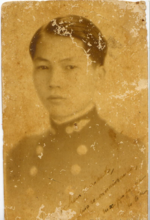
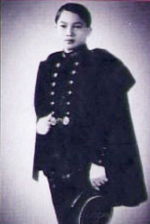
Nguyễn Ngọc Bích (1911–1966) was a French-educated engineer, a Vietnamese resistance fighter against the French colonists,[1]:850. N.psq1 a French-educated medical doctor, an intellectual and politician, who proposed an alternative viewpoint to avoid the high-casualty, high-cost war between North Vietnam and South Vietnam.[2]
The Nguyen-Ngoc-Bich street in the city of Cần Thơ, Vietnam, was named after him to honor and commemorate his feats (of sabotaging bridges to slow down the colonial French-army advances) and heroism (being on the French most-wanted list,[3]:122 imprisoned, subjected to an "intensive and unpleasant interrogation"[3]:122 that left a mark on his forehead,N.bi and exiled) during the First Indochina War.
Upon graduating from the École polytechnique (engineering military school under the French Ministry of Armed Forces) and then from the École nationale des ponts et chaussées (civil engineering) in France in 1935,[4] Dr. Bich returned to Vietnam to work for the French colonial government. After World War II, in 1945, he joined the Viet-Minh, and became a senior commander in the Vietnamese resistance movement, and insisted on fighting for Vietnam's independence, not for communism.
SuspectingN.bs of being betrayed by the Communist factionN.bs of the Viet-Minh and apprehended by the French forces, he was saved from execution by a campaign for amnesty by his École polytechnique classmates based in Vietnam, mostly high-level officers of the French army,[5]: 299 and was subsequently exiled to France, where he founded with friends and managed the Vietnamese publishing house Minh Tan (in Paris), which published many important works for the Vietnamese literature.N.mbl In parallel, he studied medicine and became a medical doctor. He was highly regarded in Vietnamese politics, and was suggested by the French in 1954 as an alternative to Ngo Dinh Diem as the sixth prime minister of the State of Vietnam under the former Emperor Bao Dai as Head of State,[6]:84 who selected Ngo Dinh Diem as prime minister. While Bich's candidature for the 1961 presidential election in opposition to Diem was, however, declared invalid by the Saigon authorities at the last moment for "technical reasons",[7][4], he was "regarded by many as a possible successor to President Ngo Dinh Diem".[7] N.pi, N.tcq
A large majority of the information in this article came from the master document Nguyen Ngoc Bich (1911–1966): A Biography,[8] which contains even more information, including primary-source evidence and photos, than presented here.
Important historical events that affected Bich's adult life, together with those mentioned in his 1962 paper (e.g., failed agrarian reform, napalm bombs, famine, conquest for rice, etc.) are summarized, in particular the atmosphere in which Bich had lived for ten years working for the French colonialists (from 1935 to 1945), and the historical conditions that drove this French-educated engineer to become a "Francophile anticolonialist"N.fa, N.psq2 and to join the Viet Minh in 1945 (e.g., the French brutal repressions in 1940 and 1945, the power vacuum after the Japanese coup de force in 1945, Ho Chi Minh's call for a general uprising from Tân Trào, the 1945 August Revolution, the Black Sunday on 1945 Sep 2 in Saigon, etc.). The key principle is to summarize a historical event only when it was directly related to Bich's activities. Care is exercised in selecting references and quotations that complement, but not duplicate, other Wikipedia articles at the time of this writing. For example, the history and the general use of napalm bombs, which Bich mentioned in his 1962 article, are not summarized. Regarding the French using American-made napalm bombs in the First Indochina War, well-known battlesN.nb are also not summarized.
First Indochina War
The broader historic events of World War II and the First Indochina War---specifically, the short interwar period between end of the former and the beginning of the later—led to the context in which Nguyen Ngoc Bich fought the French colonists until he was captured. The activities directly or indirectly affected Bich's life by four historic individuals are summarized. French General de Gaulle, by his desire to reconquer Indochina as a French colony, was a main force that led to the First Indochina War, in which Bich fought. Ho Chi Minh, founder and leader of the Viet Minh, called for the general uprising---against the French colonists and the Japanese occupiers---to which Bich responded. US President Franklin Delano Roosevelt ardent anticolonialism could have prevented the two Indochina wars, and changed the course of history. US President Harry Truman was a reason that the First Indochina War is now called the "French-American" War in Vietnamese literature,[9] and through his support for the French war effort supplied napalm bombs, which Bich mentioned in his 1962 paper. The US funded more than 30% of the war cost in 1952 under US President Eisenhower, and "nearly 80%" in 1954 under Truman.N.fwc
Charles de Gaulle
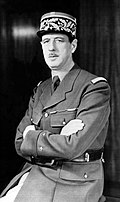
At the beginning of World War II, in his historic four-minute call-to-arms broadcast from London on 1940 June 18, later known as L'Appel du 18 Juin in French history, the mostly then unknownN.cdg1 General de Gaulle counted on the French Empire, with Indochina as the "Pearl of the Empire", rich in rubber, tin, coal, and rice,[10]:28 to provide resources to fight the Axis, with the support of the British Empire and the powerful industry of the United States. Understanding that Indochina was under the menace of occupation by the Japanese, de Gaulle harbored the dream of wresting this colony back into the fold of the French Empire, writing in his memoirs "As I saw her move away into the mist, I swore to myself that I would one day bring her back."[10]:25
"Within two weeks" of the death of US President Franklin Delano Roosevelt on 1945 Apr 12, de Gaulle pressured Harry Truman on the Indochina issue, and his government launched "an intensive propaganda effort to mold world opinion in favor of the status quo (French control) in Indochina",[11]:116 and this after having approved the Japanese occupation of Indochina since 1940 September 22.[11]:452 By the time General de GaulleN.cdg2 came to the US in 1945 Aug (inset photo) to campaign for US military aid from then US President Harry Truman, the "French had been forced to drown several Vietnamese uprisings in blood. They had seen the colonial economy completely disrupted. They had been humiliated by the Germans in Europe and incarcerated by the Japanese in Indochina. Even to begin to reassert sovereignty in Indochina, the French were forced to go hat in hand to the Americans (see inset photo, de Gaulle visited Truman), British, and Chinese."[12]:413
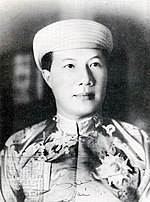
De Gaulle was a prime mover leading to the First Indochina War in which the French-educated Bich fought on the Viet Minh side against the French colonialists. On 1945 Aug 20, just ten days before he abdicated on 1945 Aug 30,N.bda Vietnam Emperor Bao Dai sent a moving plea to de Gaulle:N.bdq
Bao Dai to de Gaulle ❝I beg you to understand that the only means of safeguarding French interests and the spiritual influence of France in Indochina is to recognize the independence of Vietnam unreservedly and to renounce any idea of reestablishing French sovereignty or rule here in any form. . . . Even if you were to reestablish the French administration here, it would not be obeyed, and each village would be a nest of resistance. . . . We would be able to understand each other so easily and become friends if you would stop hoping to become our masters again.❞ --- Bao Dai, message to de Gaulle on 1945 Aug 20[13]:xiii–xiv
Just a few days later on 1945 Aug 26 (or very shortly thereafter), Ho Chi Minh put the resistance in much stronger terms to US OSS Major Archimedes Patti, who still remembered vividly after some 35 years:N.hcm1
Ho Chi Minh to Archimedes Patti ❝If the French intended to return to Viet Nam as imperialists to exploit, to maim and kill my people, [I] could assure them and the world that Viet Nam from north to south would be reduced to ashes, even if it meant the life of every man, woman, and child, and that [my] government's policy would be one of scorched earth to the end.❞ --- Ho Chi Minh to OSS Maj. Archimedes Patti[11]:4
The Southeast Asia and Buddhism expert Paul Mus, who first met Ho Chi Minh in 1945, recounted that Ho Chi Minh said[14] then:N.ytp1
Ho Chi Minh to Paul Mus ❝I have no army, no diplomacy, no finances, no industry, no public works. All I have is hatred, and I will not disarm it until I feel I can trust you [the French].❞ --- Ho Chi Minh, according to Paul Mus, the New York Times 1969 obituary[14]
Paul Mus added "For every time Ho Chi Minh has trusted us, we betrayed him."N.ytp2
Ho Chi Minh
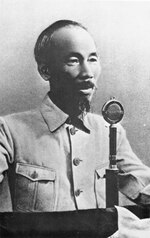

For thirty years, from 1912 when Ho Chi Minh first visited Boston and New York City until about 1948-1949, Ho held out his hope that the US would provide military support for his anticolonialist resistance against the French.[10]:xxii Since that visit to the US in his early twenties, Ho---like Bich, a Francophile anticolonialist,N.fa2 N.psq3 who was both a communist and a nationalistN.hcn ---developed a "lifelong admiration for Americans".[6]:55 N.haa
Seizing on the opportunity of the Japanese entering Tonkin in 1940 September[11]:452 to begin occupy Indochina (with French agreement)[11]:452 to rid Vietnam of French colonial yoke,N.hir Ho (who was in Liuzhou, China) returned to the China-Vietnam border and began a "training program for cadres".[11]:452 Then on 1941 February 8,[11]:524 Ho crossed the border to enter Vietnam for the first time after 30 years away (from 1911 to 1941), and sheltered in cave Cốc Bó[15]:73 near the Pác Bó hamlet, in the Cao Bằng province, less than a mile from the Chinese border.[10]:34 N.dii There Ho convened a plenum in 1941 May, and founded the Viet Minh, an anticolonialist organization that Bich joined in 1945.
On 1941 Oct 25, the Viet Minh published its first manifesto: "Unification of all social strata, of all revolutionary organizations, of all ethnic minorities. Alliance with all other oppressed peoples of Indochina. Collaboration with all French anti-fascist groups. One goal: the destruction of colonialism and imperialist fascism."N.vmm
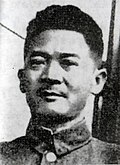
In 1942 August, Ho (named "Nguyen Ai Quoc" at that time) crossed the border into China with the intention of attracting the interest of the Allies in Chungking[11]:7 (now Chongqing) for the Vietnamese resistance movement, arrested by the Chinese on 1942 August 28 for being "French spy",[11]:525 but the real reason was Ho's political activities, viewed as "Communistic", instead of "nationalistic", by the Chinese (Chiang Kai-shek) and the Allies at Chungking (now Chongqing).[16]:103 N.vnh Ho was detained for thirteen months, starting at the Tienpao prison,[11]:51 N.htp moving through eighteen different prisons,[10]:77 N.vnh2 and ending up at Liuchow[11]:46 (now Liuzhou), from where he was released on 1943 September 10, after changing his name from Nguyen Ai Quoc to Ho Chi Minh.[11]:453 At that time, the name "Nguyen Ai Quoc" was very popular, while hardly any one heard of the new name "Ho Chi Minh".N.naq
Ho Chi Minh returned to Vietnam in 1944 September, after obtaining the authorization from the Chinese authority, Gen. Zhang Fakui (in German) (Trương Phát Khuê, in Vietnamese) ---who was under "severe pressure from the Japanese Ichigo offensive" to obtain intelligence in Indochina---and after submitting the "Outline of the Plan for the Activities of Entering Vietnam".[17]:134 N.hvn All three protagonists---the French Vichy colonialists, the Japanese occupiers, and the Viet Minh---were deceived by US war plan,N.uwp and expected a US invasion of Indochina.N.uii Such expectation was the main reason[17]:209 that, in 1945 February-March, during an "unusually cold month of February,"[11]:56 N.cf45 Ho once again crossed back into China, and walked from the Pác Bó hamlet to Kunming to meetN.wtk (and to "make friends with"[17]:210) American OSS and OWI (Office of War Information) officers to exchange intelligence.N.hmo [17]:238 Ho's report to the OSS mentioned the Japanese coup de force on the evening of 1945 March 9.[17]:238
In Kunming, Ho requested OSS Lt. Charles FennN.fhh to arrange for a meeting with Gen. Claire Chennault, commander of the Flying Tigers.[11]:58 In the meeting that occurred on 1945 Mar 29, Ho requested a portrait of Chennault, who signed across the bottom "Yours sincerely, Claire L. Chennault".[11]:58 Ho displayed the portrait of Chennault, along with those of Lenin and Mao, in his lodging at Tân Trào as "tangible evidence to convince skeptical Vietnamese nationalists that he had American support".[11]:58 As additional evidence, Ho also possessed six brand-new US Colt .45 pistols in original wrappings that he requested and got from Charles Fenn.[18]:79 [19]:158 This "seemingly insignificant quantity" of arms,N.hgp together with "Chennault's autographed photograph" as evidence, convinced other factions of the primacy of the Viet Minh. Ho's American-backing ruse worked.[11]:58
In Cochin China (the south),N.tcc where Bich lived and worked, Tran Van Giau (Trần Văn Giàu in Vietnamese), a Viet Minh leader and "Ho Chi Minh's trusted friend",[11]:186 on 1945 Aug 22 used Ho's ruse of "American backing for the Viet Minh", to convince other pro-Japanese nationalist groups (Phuc Quoc, Dai Viet, United National Front[11]:524) and religious sects (Cao Dai, Hoa Hao) that they would be outlawed by the invading Allies, and thus should accept the leadership of the Viet Minh, which had strong support of "the Allies with arms, equipment and training".[11]:186
Fearing a US invasion with the French colonialists helping, the Japanese initiated operation Bright Moon (Meigo sakusen), leading to a coup de force on 1945 March 9 to neutralize the French forces and to remove the French colonial administration in Indochina[20]:65 (and thus the status of Bich's job in the French colonial government). The resulting power vacuum[20]:64 following this coup de force changed the political situation, and provided a favorable setting for the Viet Minh takeover of the government.[20]:73 In 1945 April, Ho walked a perilous journey from Pác Bó to Tân Trào, the Viet Minh headquarters in the Liberated Area. There, on 1945 August 16, Ho called for a general uprising to throw out the Japanese occupiers that ultimately led to the August Revolution.N.pvar
Even though being a son of a Cao Dai pope,[21] [4] Bich joined the Viet Minh in 1945,N.bjvm instead of the Cao Dai force.
CBS reporter David Schoenbrun interviewed Ho Chi Minh on 1946 Sep 11, the same day that a telegram was dispatched from the High Commissioner d'Argenlieu to the French Indochina Committee on the arrest of Bich on 1946 Aug 25.:N.bb
Schoenbrun interviewed Ho Chi Minh, 1946 Sep 11 ❝President Ho, how can you possibly fight a war against the modern French army? You have nothing. You've just told me, what a poor country you are. You don't even have a bank, let alone an army, and guns, and modern weapons, the French planes, tanks, napalm. How can you fight the French? ❝And he [Ho] said: Oh we have a lot of things that can match the French weapons. Tanks are no good in swamps. And we have swamps in which the French tanks will sink. And we have another secret weapon, it's nationalism. And don't think that a small ragged band cannot fight against a modern army. It will be a war between an elephant and a tiger. If the tiger ever stands still the elephant will crush him and pierce him with his mighty tusks. But the tiger of Indochina is not going to stand still. We're going to hide in our jungles by day and steal out by night. And the tiger will jump on the back of the elephant and tear huge chunks out of his flesh and then jump back into the jungle. And after a while the mighty elephant will bleed to death. ❞
--- CBS reporter David Schoenbrun, Youtube video French involvement in Vietnam & Dien Bien Phu - 1962, time 3:10.[22]
Publications
- Nguyen-Ngoc-Bich (March 1962), "Vietnam—An Independent Viewpoint", The China Quarterly 9. Retrieved on 18 Feb 2023, pp. 105–111. See also the contents of Volume 9, which included the articles of many experts on Vietnam history and politics such as Bernard B. Fall, Hoang Van Chi, Phillipe Devillers (see, e.g., his classic 1952 book Histoire du Viet-Nam in Section References and French French Cochinchina, Ref. 40), P. J. Honey, Gérard Tongas (see, e.g, J'ai vécu dans l'Enfer Communiste au Nord Viet-Nam, Debresse, Paris, 1961, reviewed] by P. J. Honey), among others.
Notes
(↑ NOTE) How to create the Note jump-to and jump-back links: The Note link-labels, such as N.bda in superscript, are unique identifiers for the corresponding Notes, with "N" standing for "Note", followed by a period and three or four characters summarizing the Note contents, e.g., "bda" for "Bao Dai abdication," which is the title (in italics) of the Note (jump-to) link N.bda. In front of each Note, the uparrow ↑ preceeding a Note (jump-back) link such as (↑ N.bda) indicates the link to jump back UP to the main text where the jump-to link N.bda appears.
The target of the jump-back link (↑ N.bda) is the HTML anchor with the code <span id="Bao Dai abdication jump"></span> having the anchor name being "Bao Dai abdication jump", without an Anchor_text (or link text, or link label) inside. The code [[#Bao Dai abdication jump|N.bda]] creates the jump-back link (see Help:Link) with label "N.bda" to jump back UP to the main text where the anchor with anchor name "Bao Dai abdication jump" was embedded.
NEW Notes not yet reorganized
Notes reorganized
- (↑ N.bda) Bao Dai abdication: Under the pressure of the Viet Minh,[11]:186-187 Bao Dai had decided to abdicate on 1945 Aug 24,[11]:186-187 and abdicated officially on 1945 Aug 30.[11]:220 Ho Chi Minh then appointed "Mr. Nguyen Vinh Thuy" (Bao Dai's birth name) as "Supreme Counsellor"[11]:220 of the Provisional Government of Vietnam.[11]:220
- (↑ N.bda) Bao Dai quote: In the foreword by Devillers for Tønnesson's 2010 book Vietnam 1946.[13]:xiii-xiv
- (↑ N.bs) Betrayal suspicion: On the betrayal suspicion, Cooper, Chester L. (1970), The Lost Crusade: America in Vietnam, Dood, Mead & Company, New York. Retrieved on 7 Mar 2023, p.123, wrote: "Whether the Viet Minh had actually betrayed him to French agents is not known for certain, but Bich always suspected that this was how he had been discovered," whereas the assertion that he "was betrayed by his Communist colleagues to the French" was written in the short biography that accompanied Bich's 1962 article, as written in Honey, P.J., ed. (March 1962), "Special Issue on Vietnam", The China Quarterly 9. Retrieved on 18 Feb 2023. Volume 9. See the Note on The China Quarterly.
- (↑ N.bi) Bich's injury: A photo showing the injury mark on the forefront of Dr. Bich as a result of this "intensive and unpleasant interrogation" can be found in Nguyen Ngoc Bich (1911–1966): A Biography.[8]
- (↑ N.bjvm) Bich joined Viet Minh: See the quotation from a French doctoral thesis in Nguyen Ngoc Bich (1911–1966): A Biography.[8]
- (↑ N.tcq) China Quarterly: The Editorial of The China Quarterly, Volume 9, reads: "Five of our articles are by specialists who have observed the Hanoi regime from a distance. M. Tongas and Mr. Hoang Van Chi are writing on the basis of personal experience. Dr. Bich presents an independent view of the whole Vietnamese situation." This China Quarterly issue contained the articles written by several well-known intellectuals on Vietnam history and politics such as Bernard B. Fall, Hoang Van Chi, Phillipe Devillers (See Philippe Devillers (1920–2016), un secret nommé Viêt-Nam, Mémoires d'Indochine, Internet archived 2022.06.29), P. J. Honey, William Kaye (see e.g., A Bowl of Rice Divided: The Economy of North Vietnam, 1962), Gerard Tongas, among others. See the Editorial and the brief introduction of the contributors.
- (↑ N.cf45) Cold February 1945: It has never been that cold. The temperature went down to four degrees Celcius at noon in Hanoi on 1945 Feb 13, Tết, new year day, Lunar year Ất-Dậu ("13-2-1945, Tết Nguyên Đán Ất-Dậu. Chưa bao giờ rét như thế này. Tại Hà Nội, buổi trưa, hàn thử biểu xuống tới 4 độ"[23]:3).
- (↑ N.cdg1, N.cdg2) De Gaulle: The permanent undersecretary at the British Foreign Office knew only that de Gaulle had a 'head like a pineapple and hips like a woman's', whereas the counselor at the US embassy in Paris and most of de Gaulle compatriots never heard of him.[10]:24 By Aug 1946, de Gaulle had resigned from the presidency of the French Provisional Government on 1946 Jan 20.[24]
- (↑ N.dii) Devillers incorrect info: Devillers (1952) received incorrect information that Ho was in "Tsin Tsi" (Jingxi, Guangxi, China) as he wrote:[16]:97 "En mai 1941, il réussit à convoquer à Tsin Tsi dans le Kwang Si, à 100 km environ au Nord de Cao Bang, un 'Congrès' (In May 1941, he succeeded in calling for a plenum at Jingxi in the Guangxi province, about 100 km north of the Cao Bang province)."
- (↑ N.fhh) Fenn helped Ho: OSS Lt. Charles Fenn helped "make Ho Chi Minh the undisputed leader of the Viet Minh in 1945".[19]:96
- (↑ N.fa1, N.fa2) Francophile anticolonialists: "French teachings and models over Confucian ones. Some of these teachings were, to say the least, unhelpful to the colonial enterprise. Voltaire's condemnation of tyranny, Rousseau's embrace of popular sovereignty, and Victor Hugo's advocacy of liberty and defense of workers' uprisings turned some Vietnamese into that curious creature found also elsewhere in the empire: the Francophile anticolonialist."[10]:9
- (↑ N.fwc) French-war cost: PBS US Involvement in Vietnam Video time 0:11 to 0:32:[25] "In 1952, General Dwight Eisenhower was elected President, in part because he promised to take a tougher stance on communism. That year, American taxpayers were footing more than 30% of the bill for the French war in Vietnam (also called the "French-American" war[9]). Within two years, that number would rise to nearly 80%." To be more precise, the "U.S. aid to the French military effort mounted from $130 million in 1950 to $800 million in 1953."[26]:597 The "United States became France's largest patron, ultimately funding 78 percent of the French war effort in Indochina,"reported historian L.H.T. Nguyen based on the Vietnamese document "Tong ket cuoc khang chien chong thuc dan Phap," Hanoi: Chinh Tri Quoc Gia, 1996.[27]:46
- (↑ N.haa) Ho admires Americans: As cited in Logevall (2012),[10]:721 Note 22, p. 721: "Former New York Times Saigon correspondent A. J. Langguth, in his fine history of the American war, refers to Ho Chi Minh's 'lifelong admiration for Americans.' "[6]:55
- (↑ N.hcn) Ho, communist or nationalist? "For many decades there would be a heated debate among diplomats, politicians and political scientists in every corner of the world as to whether Ho Chi Minh was a communist or a nationalist. The answer is that he was both."[17]:120
- (↑ N.hgp) Ho gave pistols: That Ho gave the new pistols to his rivals, but not to his own people, testified to his political acumen in rallying his rivals to accept him as the top leader.[28]
- (↑ N.htp) Ho in Tienpao prison: Tienpao in the Wade-Giles transliteration is Tianbao in pinyin. See the analysis in Notes on Vietnam History.[28]
- (↑ N.hvn) Ho in Vietnam 1944: A French report at that time stated: "more than 200 political refugees had passed from China to Tonkin, most of them armed with pistols and daggers (poiguards), and that among them was a certain 'Nguyen Hai Quoc', who had crossed the border under the name of 'Ho Chi Minh'. Nguyen Hai Quoc, a man 'around sixty years old', was 'the probable leader' of the Viet Minh: 'Under Nguyen Hai Quoc's leadership, the new elements coming from Kwangsi have undertaken to reawaken the movement and bring back to their former activities the implacables who had taken refuge in the mountains.' "[17]:118, 208
- (↑ N.hmo) Ho met OSS: Ho's "mission was probably to obtain information on the development of the war, try to gain Allied recognition for his league and perhaps also secure the Viet Minh a role in a forthcoming invasion". At the same time, Hoang Quoc Viet carried out a similar mission in Kwangsi (now Guangxi) with the Chinese Template:Lang-de, who told him that "I hope we shall soon meet again in Hanoi".[17]:210 See also the PBS interview with Hoang Quoc Viet in 1981.
- (↑ N.hir) Ho's insight for revolution: Ho was convinced that with the Japanese occupation of Indochina and "with international events moving fast and Decoux's government isolated from metropolitan France, the potential for revolution in Vietnam was much enhanced."[10]
- (↑ N.mbl) Minh Tan book list: A list of important books published by Minh Tan can be found in Nguyen Ngoc Bich (1911–1966): A Biography.
- (↑ N.nb) Napalm battles: See, e.g., the battle of Vinh Yen (1951), the battle of Na San (1952), the battle of Dien Bien Phu (1954), etc.
- (↑ N.naq) Nguyen Ai Quoc: Hoang Quoc Viet recounted in his 1981 interview with the PBS: "I was sent to the southern part of the country at one point to discuss things with our comrades there. The discussion was very heated and it was very difficult to iron things out. Then I happened to mention the name Ho Chi Minh. These people in the south asked me who Ho Chi Minh was. I told them that he was Nguyen Ai Quoc. They all stood up and clapped and said that as I was a representative sent by Ho Chi Minh then there was no need for any further discussion. This was because at that time there was a feud going on between the so called "Old Viet Minhs" and "New Viet Minhs". But when they heard from me that Ho Chi Minh was indeed Nguyen Ai Quoc, they were all overjoyed, saying that if Nguyen Ai Quoc had returned home to lead the movement then everything would be solved, that there should be unity and solidarity."
- (↑ N.pi) Political influence: A direct quote from the brief introduction of the contributors to The China Quarterly, Volume 9, 1962, reads: Dr. Bich's "personal influence upon Cochin Chinese opinion is considerable, and he is regarded by many as a possible successor to President Ngo Dinh Diem".
- (↑ N.pvar) Power vacuum to August Revolution: "In August and September 1945, the white-bearded Ho Chi Minh emerged as the winner of the Indochina game. ... He expected an Allied invasion and prepared himself for assisting the invading forces. Instead he got a power vacuum and a sudden Japanese surrender. This provided him with an occasion more favorable for bloodless revolution than he could ever have imagined. He then proclaimed the republic that would later defeat both France and the United States."[20]:73
- (↑ N.psq1, N.psq2, N.psq3) Primary sources, quotations: See primary sources, extensive notes and quotations in Nguyen Ngoc Bich (1911–1966): A Biography[8] and Notes on Vietnam History.[28]
- (↑ N.tcc) Taberd Cochin China: Jean-Louis Taberd was likely among the first to explain the meaning of "Cochin China" in his 1837 scientific article; see quotation in Notes on Vietnam History.[28]
- (↑ N.uii) US invasion of Indochina: The US was the only country among the Allies (British and Chinese) that could invade Indochina; see Chap. 4, Colliding Plans, in Tønnesson (1991).[17]:156
- (↑ N.uwp) US war plan: "... to confuse the Japanese, possibly the French as well, concerning US intentions. Perhaps Roosevelt meant the plan seriously at first, and then changed it into a deceptive operation when he realized that it could not be carried out ... Indochina came to play a similar role in Roosevelt's war against Japan as Norway occupied in Churchill's war against Germany. For a long time, Churchill toyed with the idea of a Norwegian landing as a way of securing the transport route to Russia and bringing Sweden into the war. Then, when his generals and admirals adamantly refused to carry out the project, Norway instead became the focus of elaborate deception and diversion plans, aiming at inducing Hitler to keep as many troops as possible in an irrelevant theatre."[17]:170, 220
- (↑ N.vmm) Viet Minh manifesto: "Union de toutes les couches sociales, de toutes les organisations révolutionnaires, de toutes les minorités ethniques. Alliance avec tous les autres peuples opprimés de l'Indochine. Collaboration avec tous les élements antifascistes français. Un but: la destruction du colonialisme et de l'impérialisme fascistes."[16]:97
- (↑ N.wtk) Walking to Kunming: It takes about two weeks to walk from Pác Bó to Kunming using likely the same road (among several others) undertaken by the invading Mongols in the thirteen century.[29]
- (↑ N.ytp1, N.ytp2) Year of the Pig: In his interview in the 1968 documentary In the Year of the Pig, at the Youtube video time 13:56, Paul Mus recounted: "Ho Chi Minh said [in 1945], 'I have no army.' That's not true now [in 1968]. 'I have no army.' 1945. 'I have no finance. I have no diplomacy. I have no public instruction. I have just hatred and I will not disarm it until you give me confidence in you.' Now this is the thing on which I would insist because it's still alive in his memory, as in mine. For every time Ho Chi Minh has trusted us, we betrayed him."
References
Buttinger 1967a[30], Marr 1984[12], Marr 2013[31],
- ↑ Buttinger, Joseph (1967b), Vietnam: A Dragon Embattled, Vol.2, Frederik A. Praegers, New York. Retrieved on 25 Feb 2023
- ↑ Nguyen-Ngoc-Bich (March 1962), "Vietnam—An Independent Viewpoint", The China Quarterly 9. Retrieved on 18 Feb 2023, pp. 105–111. See also the contents of Volume 9, which included the articles of many well-known experts on Vietnam history and politics such as Bernard B. Fall, Hoang Van Chi, Phillipe Devillers (see, e.g., his classic 1952 book Histoire du Viet-Nam in Section References and French French Cochinchina, Ref. 40), P. J. Honey, Gerard Tongas (see, e.g, J'ai vécu dans l'Enfer Communiste au Nord Viet-Nam, Debresse, Paris, 1961, reviewed] by P. J. Honey), among others.
- ↑ Jump up to: 3.0 3.1 Cooper, Chester L. (1970), The Lost Crusade: America in Vietnam, Dood, Mead & Company, New York. Retrieved on 7 Mar 2023
- ↑ Jump up to: 4.0 4.1 4.2 Nguyen-Ngoc-Chau (2018), Le Temps des Ancêtres: Une famille vietnamienne dans sa traversée du XXe siècle, L'Harmattan, Paris, France. Retrieved on 18 Feb 2023. Preface by historian Pierre Brocheux.
- ↑ Tran-Thi-Lien (2002), Henriette Bui: The narrative of Vietnam's first woman doctor, in Gisele Bousquet and Pierre Brocheux, Viêt Nam Exposé: French Scholarship on Twentieth-Century Vietnamese Society, University of Michigan Press, ISBN 9780472098057, DOI:10.3998/mpub.12124, at 278–309. Google Book (search for "Bui Quang Chieu Ngoc Bich"), accessed 20 May 2023.
- ↑ Jump up to: 6.0 6.1 6.2 Langguth, Arthur John (2000), Our Vietnam: The war, 1954–1975, Simon & Schuster, New York. Retrieved on 14 Mar 2023
- ↑ Jump up to: 7.0 7.1 Honey, P.J., ed. (March 1962), "Special Issue on Vietnam", The China Quarterly 9. Retrieved on 18 Feb 2023.
- ↑ Jump up to: 8.0 8.1 8.2 8.3 8.4 Nguyen-Ngoc-Chau & Vu-Quoc-Loc (2023), Nguyen Ngoc Bich (1911–1966): A Biography, Internet Archive. Retrieved on 21 Mar 2023, CC-BY-SA 4.0. (Backup copy.) Much of the information in the present article came from this biography, which also contains many relevant and informative photos not displayed here.
- ↑ Jump up to: 9.0 9.1 Lady Borton (2020), WE NEVER KNEW: Napalm use during Vietnam's French-American War, vietnamnet.vn, May 5.
- ↑ Jump up to: 10.0 10.1 10.2 10.3 10.4 10.5 10.6 10.7 10.8 Logevall, Fredrik (2012), Embers of War: The Fall of an Empire and the Making of America's Vietnam, Random House, New York. Retrieved on 12 Apr 2012, 864 pp. Winner of the 2013 Pulitzer Prize in History: "For a distinguished and appropriately documented book on the history of the United States, Ten thousand dollars ($10,000). A balanced, deeply researched history of how, as French colonial rule faltered, a succession of American leaders moved step by step down a road toward full-blown war" • Winner of the 2013 Francis Parkman Prize from the Society of American Historians • Winner of the 2013 American Library in Paris Book Award • Winner of the Council on Foreign Relations 2013 Gold Medal Arthur Ross Book Award • Finalist for the 2013 Cundill Prize in Historical Literature.
- ↑ Jump up to: 11.00 11.01 11.02 11.03 11.04 11.05 11.06 11.07 11.08 11.09 11.10 11.11 11.12 11.13 11.14 11.15 11.16 11.17 11.18 11.19 11.20 11.21 11.22 11.23 11.24 11.25 Patti, Archimedes (1980), Why Viet Nam? Prelude to America's Albatross, Berkeley: University of California Press, ISBN 978-0520047839
- ↑ Jump up to: 12.0 12.1 Marr, David G. (1984), Vietnamese Tradition on Trial, 1920-1945, University of California Press, Berkeley. Retrieved on 2024-05-05.
- ↑ Jump up to: 13.0 13.1 Tønnesson, Stein (2010), Vietnam 1946: How the War Began, University of California Press, Berkeley, California. Retrieved on 2024-05-05.
- ↑ Jump up to: 14.0 14.1 "Dr. Paul Mus dies; a Yale professor. Southeast Asia authority also taught in France", New York Times, 16 August 1969.
- ↑ Brocheux, Pierre (2007), Ho Chi Minh: A Biography, translated by Claire Duiker, Cambridge University Press, New York. Retrieved on 2024-05-20.
- ↑ Jump up to: 16.0 16.1 16.2 Devillers, Philippe (1952), Histoire du Viêt-Nam de 1940 à 1952, Seuil, Paris. See also Philippe Devillers (1920–2016), un secret nommé Viêt-Nam, Mémoires d'Indochine, Internet archived 2022.06.29. Patti (1980), p.542, wrote about Devillers (1952): "The most accurate French account of the period; barring several omissions and minor inaccuracies generally attributable to his sources and to the lack of American documentation, it is by far one of the more reliable histories."
- ↑ Jump up to: 17.0 17.1 17.2 17.3 17.4 17.5 17.6 17.7 17.8 17.9 Tønnesson, Stein (1991), The Vietnamese Revolution of 1945: Roosevelt, Ho Chi Minh and de Gaulle in a world at war, SAGE Publications, London. Retrieved on 2024-05-05. Link to this book at the Norwegian National Library.
- ↑ Fenn, Charles (1973), Ho Chi Minh: A Biographical Introduction, Studio Vista, London. Retrieved on 2023-12-27.
- ↑ Jump up to: 19.0 19.1 Bartholomew-Feis, Dixee (2006), The OSS and Ho Chi Minh: Unexpected Allies in the War against Japan, University Press of Arkansas, Lawrence, Kansas. Retrieved on 2024-05-23.
- ↑ Jump up to: 20.0 20.1 20.2 20.3 Tønnesson, Stein (2007), Franklin Roosevelt, Trusteeship and Indochina: A reassessment, The First Vietnam War: Colonial Conflict and the Cold War, Harvard University Press, Massachusetts, at 56-73.
- ↑ Tram-Huong (2003), Đêm trắng của Đức Giáo Tông (Sleepless Night of the Cao Dai Pope), People's Police Publishing House, Vietnam.
- ↑ Giniger, Henry (1984-10-14), America Inside Out, Close to Events, book review.
- ↑ Đoàn-Thêm (1965), Hai Mươi Năm Qua: Việc Từng Ngày, (1945-1964) Template:Bracket, Xuân Thu (1986?), Los Alamitos, California. Template:Plain link (read only, cannot search). HathiTrust Digital Library (search only, cannot read).
- ↑ Charles de Gaulle (1959-1969), Former Presidents of the Republic, 15 November 2018. Retrieved on 13 Jun 2023. Internet archived on 2023.03.28.
- ↑ US Involvement in Indochina. Retrieved on 2023-12-09, PBS Learning Media, Illinois. Teaching video excerpt from the documentary The Vietnam War, a film by Ken Burns and Lynn Novick.
- ↑ Encyclopedia of American Foreign Policy, vol. 3, Charles Scribner's & Sons, 2002. Retrieved on 2024-05-11.
- ↑ The First Vietnam War: Colonial Conflict and the Cold War, Harvard University Press, Massachusetts, 2007.
- ↑ Jump up to: 28.0 28.1 28.2 28.3 28.4 Vu Quoc Loc (2023a), Notes on Vietnam History, Internet Archive. Retrieved on 27 Jun 2023, CC BY-SA 4.0.
- ↑ Vu-Quoc-Loc (2023b), Marco Polo's Caugigu - Phạm Ngũ Lão's Đại Việt - 1285, Internet Archive. Retrieved on 23 Apr 2023, CC BY-SA 4.0.
- ↑ Buttinger, Joseph (1967a), Vietnam: A Dragon Embattled, Vol.1, Frederik A. Praegers, New York. Retrieved on 25 Feb 2023
- ↑ Marr, David G. (2013), Vietnam: State, War, and Revolution (1945-1946), University of California Press, Berkeley.
External links
- Draft:Nguyen Ngoc Bich on Wikipedia, where anonymous users can edit.
